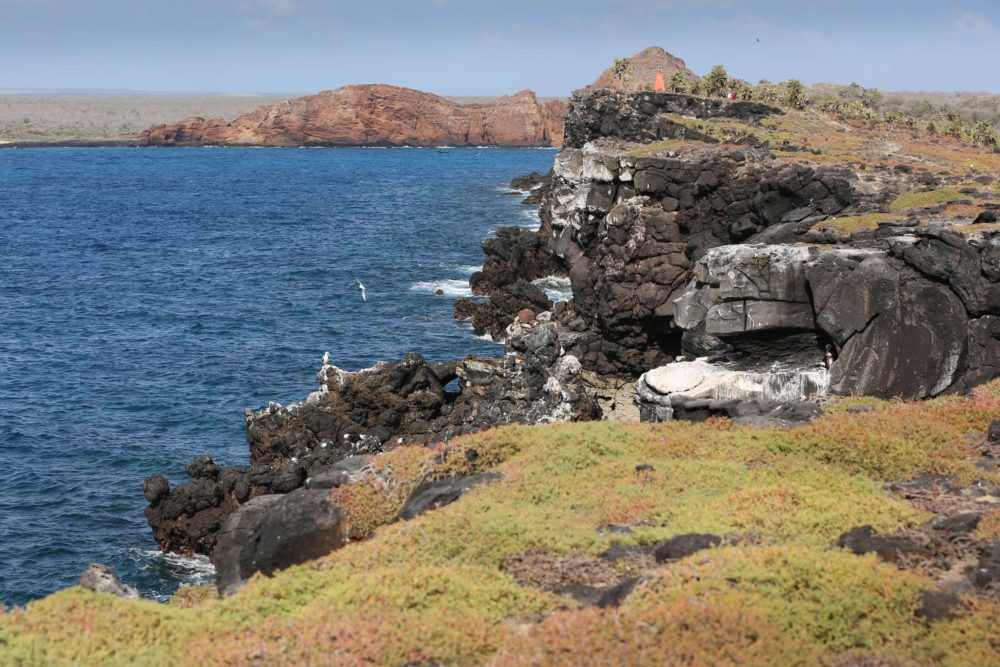
The Galapagos Islands offer spectacular views and crystal clear waters. An inflatable boat wends its way through sharp reefs on its way to shore.

A group of tourists is outnumbered by the birds flying overhead.

Frigate birds are some of the Galapagos Islands’ most well-known residents. Males are easily distinguishable.

A male frigate bird puffs up his pouch to make himself better seen and more attractive.

Frigate birds nest on the ground, gathering sticks into a crude pile.

With a long wingspan and aerodynamic body, frigate birds can soar on the winds with little effort.

The Galapagos Islands are both rugged and beautiful; everywhere you look is nature at its finest.
The Galapagos Islands are a must-see experience for world travelers and anyone interested in ecology, species protection and preservation, and glimpsing a part of the world that remains pristine.

These smooth worn rocks spill down toward the surf.

A mother sea lion and her pup pause in the afternoon sun.

This dozing sea lion isn’t bothered in the least by the small lizard that has climbed aboard.

This young sea lion sticks a flipper in the air as it eases along, with no worries or hurries.

These rocks are white and smooth because sea lions have spent years hauling themselves over them and defecating on them, bleaching the rocks.
The unique character of these islands has been featured in countless articles, documentaries and television programs produced by luminaries such as Jacques Cousteau, David Attenborough and National Geographic. Historically, Charles Darwin’s experience at that remote archipelago sparked his imagination and led to his groundbreaking theory of evolution.

You need a tough mouth and digestive system to snack on cactus pads with thorns.

There’s plenty of food on the Galapagos Islands, but it’s interesting the lengths some reptiles will go for a meal.

Iguanas are cold-blooded reptiles and warm rocks help to raise their body temperature.
Those lucky enough to visit the islands and swim among the fish and marine creatures will be one-of-a-kind activities that form life long memories. But getting to the Galapagos Islands is no easy task, based on remoteness and location. Currently there are 18 major islands, a few smaller islands and more than 100 islets and rocks. The largest island, Isabela (Albermarle) Island is only 1,792 square miles and Wolf (Wenman) Island is only one-half square mile in size.

Some of the islands are within sight of each other, and some are separated by long distances.

Each of the Galapagos Islands offers something different to enjoy. Here cactus and low lying succulents have taken hold.
The islands are located more than 600 miles off the coast of Ecuador and are situated on the equator. Volcanism produced the chain of islands and some of the oldest above-water islands are more than four million years old. Volcanic activity is ongoing even today and scientists predict the emergence of additional islands in the future. The equatorial location places it the sweet spot of Pacific Ocean currents, providing a nutrient rich menu for the birds, animals and fish that live there.

Differences among the islands’ finches and other birds were noted by Charles Darwin, who would later develop the theory of evolution.

Humans would be wise to watch their step while ashore at the Galapagos Islands, but this small bird has no problem with a cactus landing.

Blue footed boobies were so named by sailors who thought they looked silly because of the color of their feet and the way they walked.
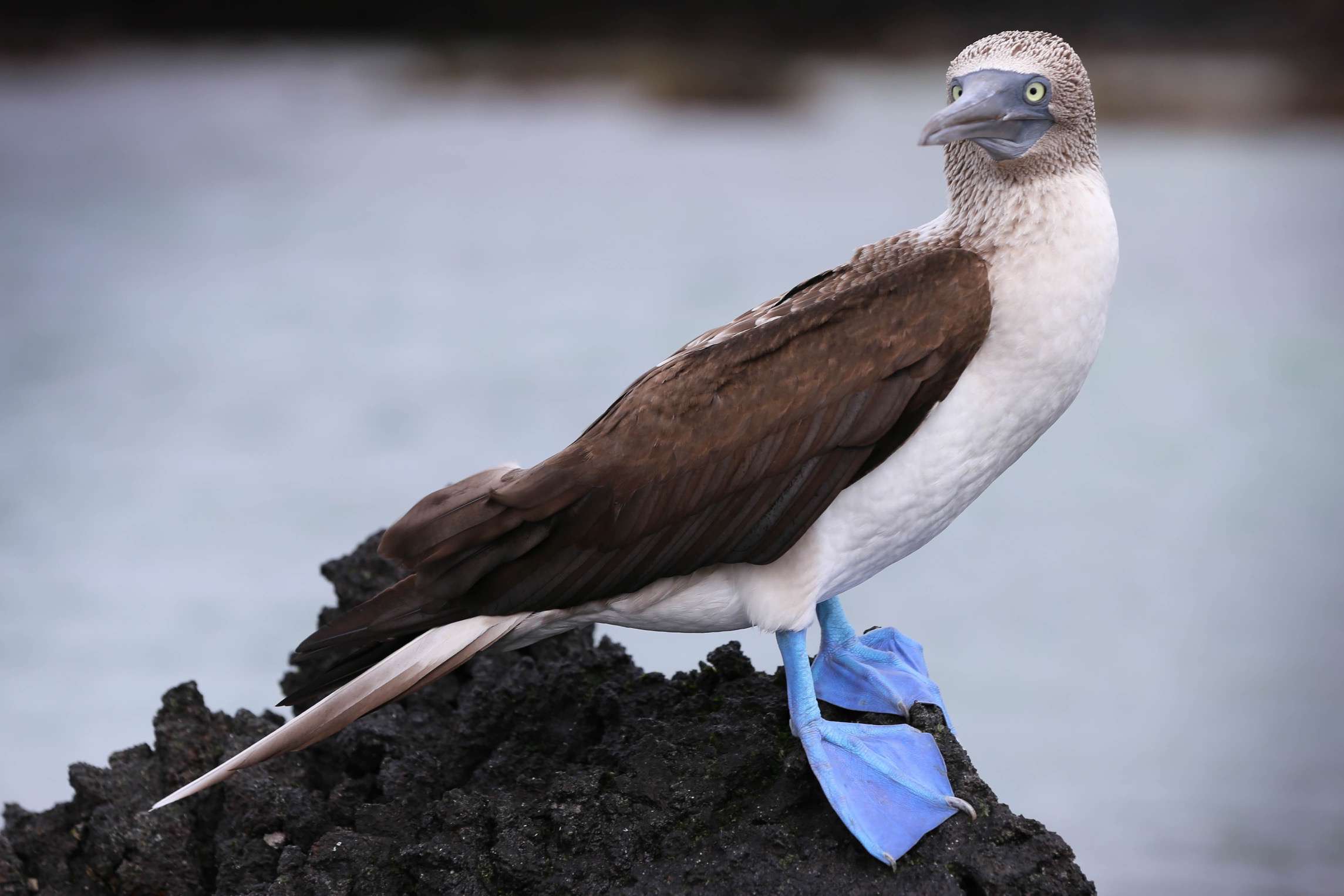
A blue-footed booby poses patiently on a rock as gawking tourists snap pictures.

A blue-footed booby takes flight.

The red-footed booby is the smallest of the half-dozen species of boobies. They are agile fliers, but a a bit awkward on take off and landing.

Frigate birds are graceful fliers, but they do not produce enough oil to waterproof their feathers, so they obtain food mainly by stealing.

The male frigate bird mates with one female, while another, left, watches for other frigates that might swoop in.

A Galapagos heron ambles along.

A pelican watches tourists watching him.
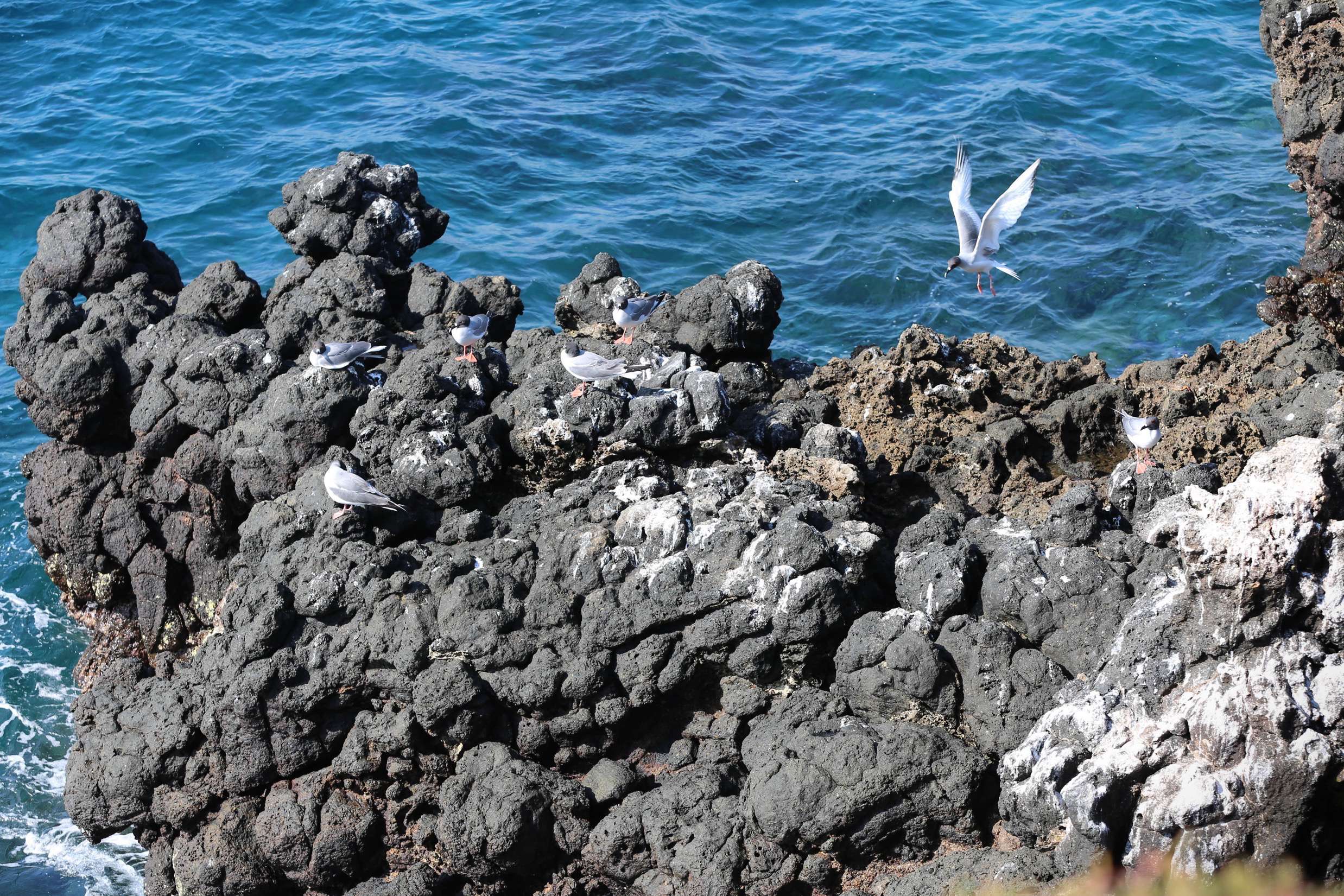
Rocky ledges are ideal spots for birds to nest, relax and take wing.

Galapagos Penguins are the second smallest penguin species and might grow to 19 inches. This one has a some algae on its belly.
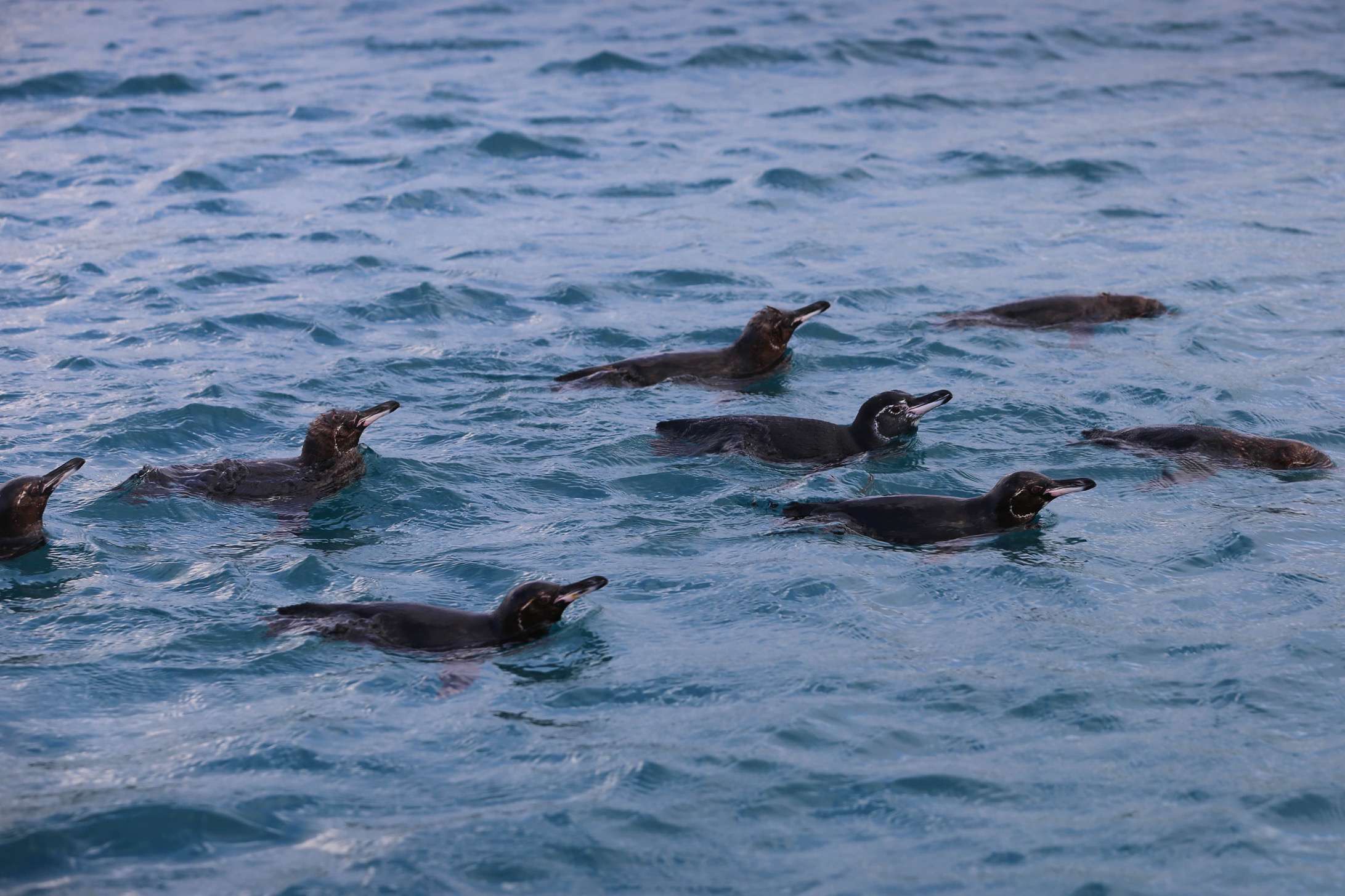
A raft of Galapagos Penguins out looking for food.

All penguins are agile in water, but a bit clumsy on land. This Galapagos Penguin eyes its next move.

Not all birds in the Galapagos nest on the ground.

This nest tucked between the leaves of a cactus offers great security.

This pair of diving sea birds have spotted some fish and begin their dive…

As they approach their targets, they tuck their wings and pierce with water like spears finding their mark.
Part of what makes the Galapagos Islands historically significant is the five weeks a young naturalist spent cataloguing and observing the creatures that lived there. Interestingly, Charles Darwin only visited four of the archipelago’s islands. Darwin was the son and grandson of scientists and was only 21 years old when assigned as the naturalist aboard the HMS Beagle, a voyage to map sea routes and key land formations for the British Royal Navy. It would turn into a five-year voyage that began in December 1831. In 1859 Darwin published his groundbreaking book, “The Origin of Species.” The initial print run of 12,000 copies sold out in a matter of hours, and his theories ignited a firestorm of controversy. And by the way, Darwin never suggested that man descended from the apes.
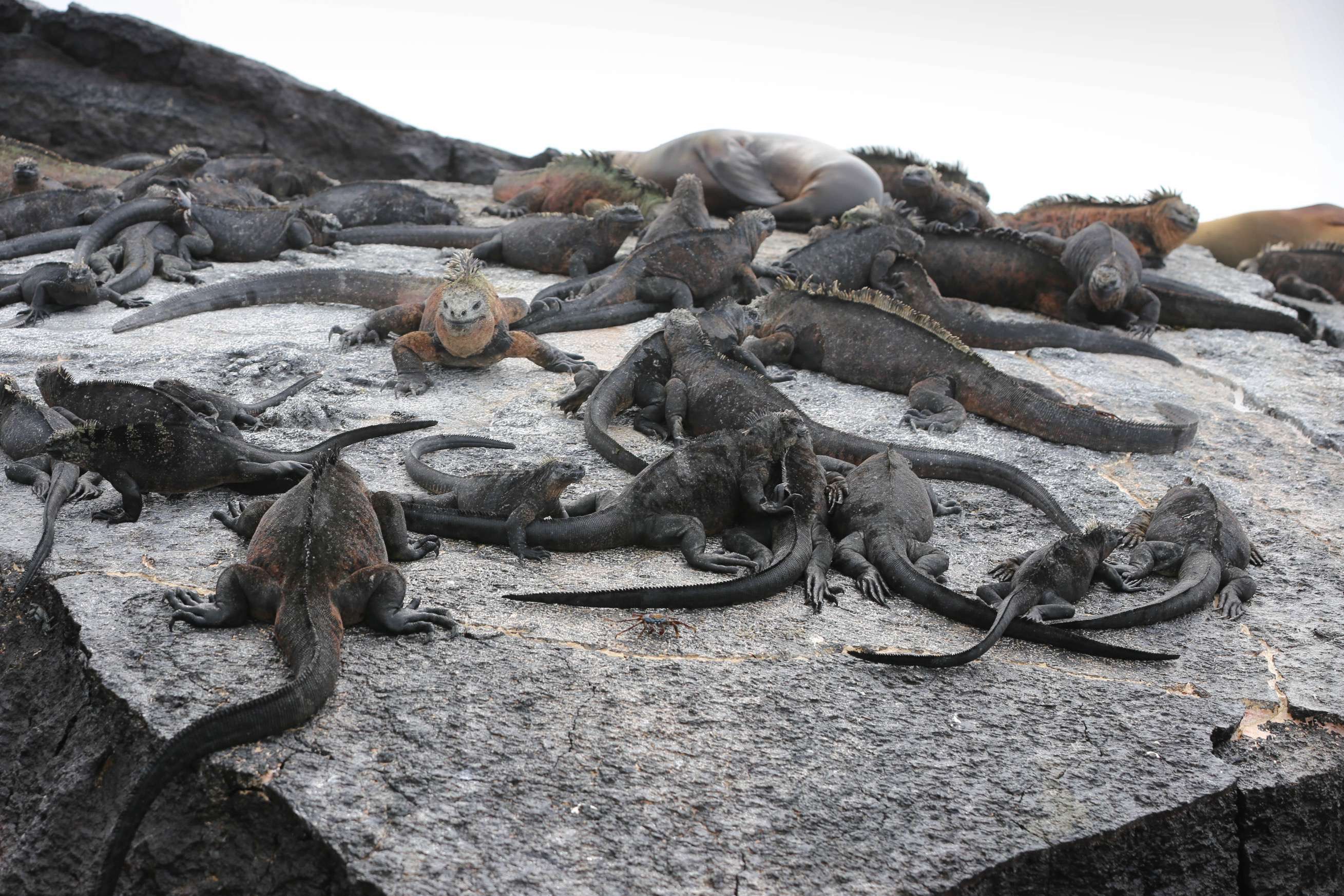
This mess of iguanas loll about on volcanic island rocks.

Iguanas have different colors for a variety of reasons including mating cycles, body temperature and habitat.

Adaptation was one of the groundbreaking ideas that Darwin developed in his theory of evolution. Color is just one example of that.

This iguana displays some beautiful pigments as it warms itself in the sun.
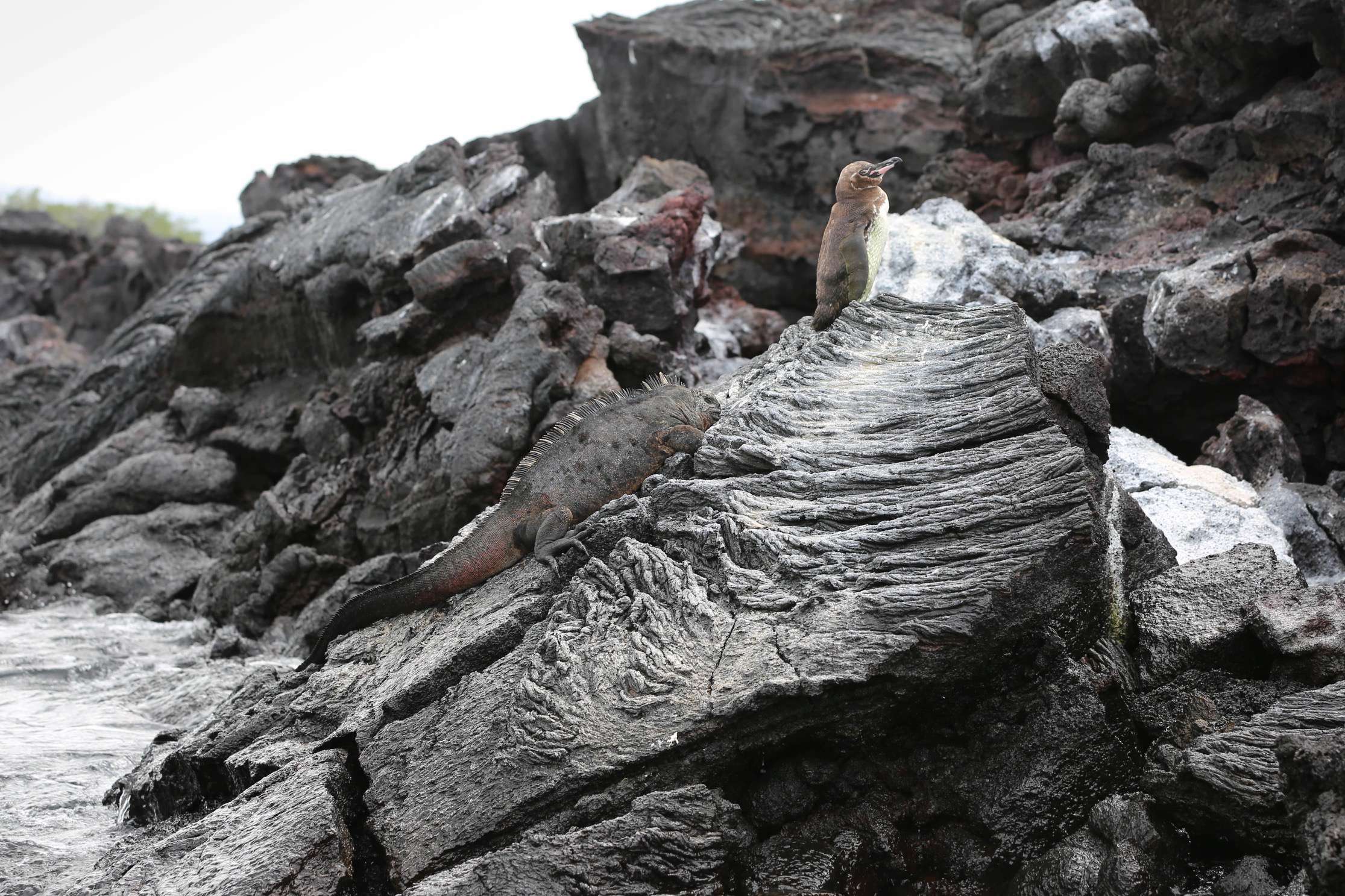
Look carefully and you’ll see an iguana sharing this outcrop with a Galapagos penguin.

The lava that flows up from under the sea is a primordial creation that cooled to become this iguana’s resting spot.
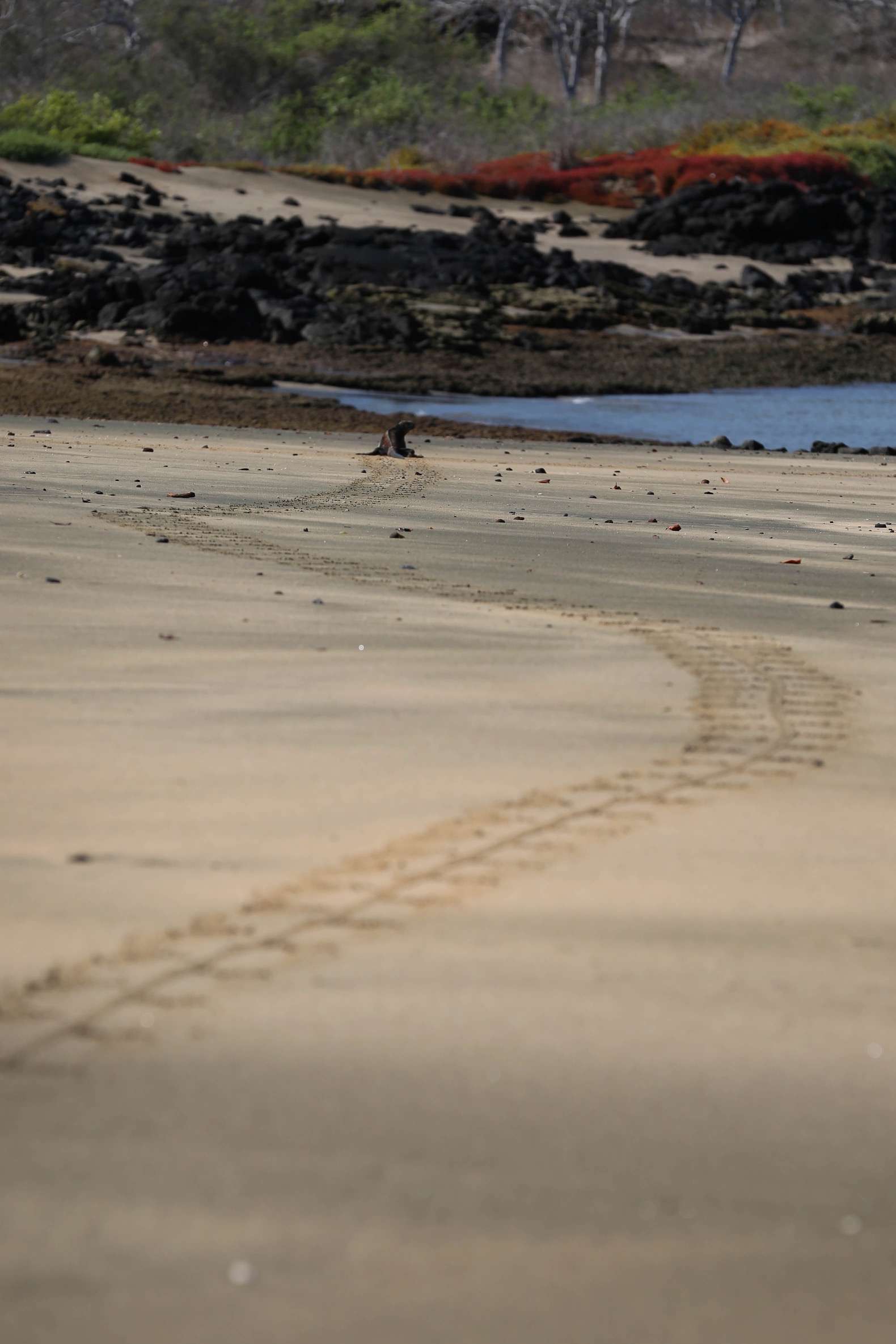
Nature is undisturbed and unhurried as this iguana, top, leaves its tracks in the sand on a Galapagos Island.

Sally Lightfoot crabs are small and one of the most vividly-colored inhabitants where sea and rocks meet.

A Sally Lightfoot crab perches on a rock in search for morsels of food.
There are only two ways to get to the islands, either by air or boat. And while there, visitors must adhere to 14 rules established by the Galapagos National Park Directorate. Some of the rules visitors must follow include being accompanied by a certified naturalist when visiting any of the protected areas. Animals are not hunted or harassed by people so they show no fear of humans, which means visitors must remain at least six feet from them. Feeding the animals, flash photography, smoking, campfires on beaches, and straying from marked trails are all prohibited, among other rules.

This is a beach is a turtle nesting preserve. The depressions are where they have dug their nests and laid their eggs.

Sometimes the turtles lay eggs too close to the water and they don’t warm enough to develop, or other creatures come and dig up the eggs. A naturalist displays a turtle egg that will never hatch.
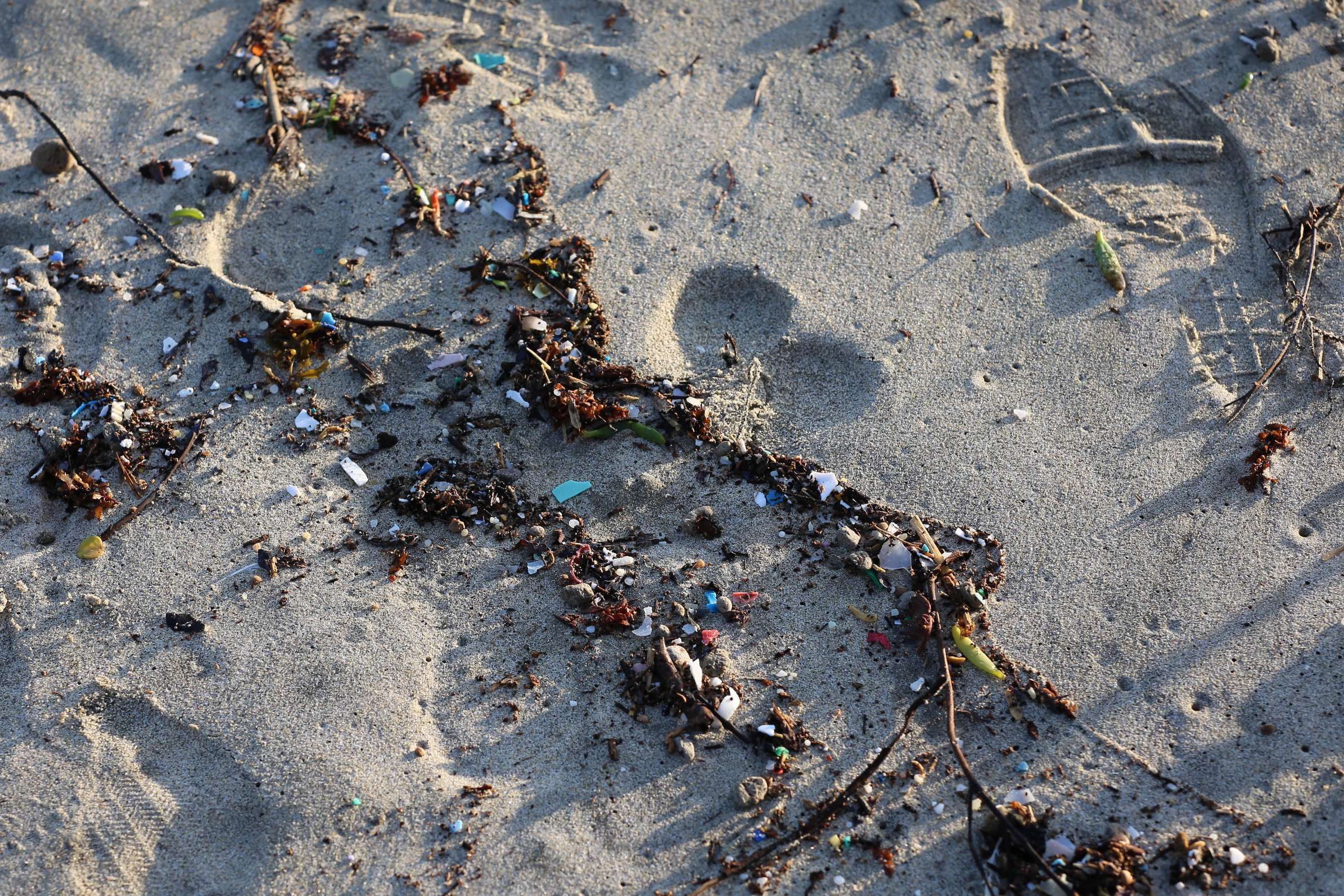
The footprints will disappear but plastics in the ocean are ground into small pieces that are mistaken for food by birds, turtles, sea lions and other animals. Currents washed this blight ashore at the turtle nursery.
The strict rules, watchful eyes of naturalists, small groups and being with like-minded travelers helps make the Galapagos Islands experience all the more enjoyable. It is a photographer’s joy and a nature lover’s Eden. Snorkeling or scuba diving in warm crystal clear water places you among thousands of fish, alongside playful sea lions, sea turtles and even a shark or two.
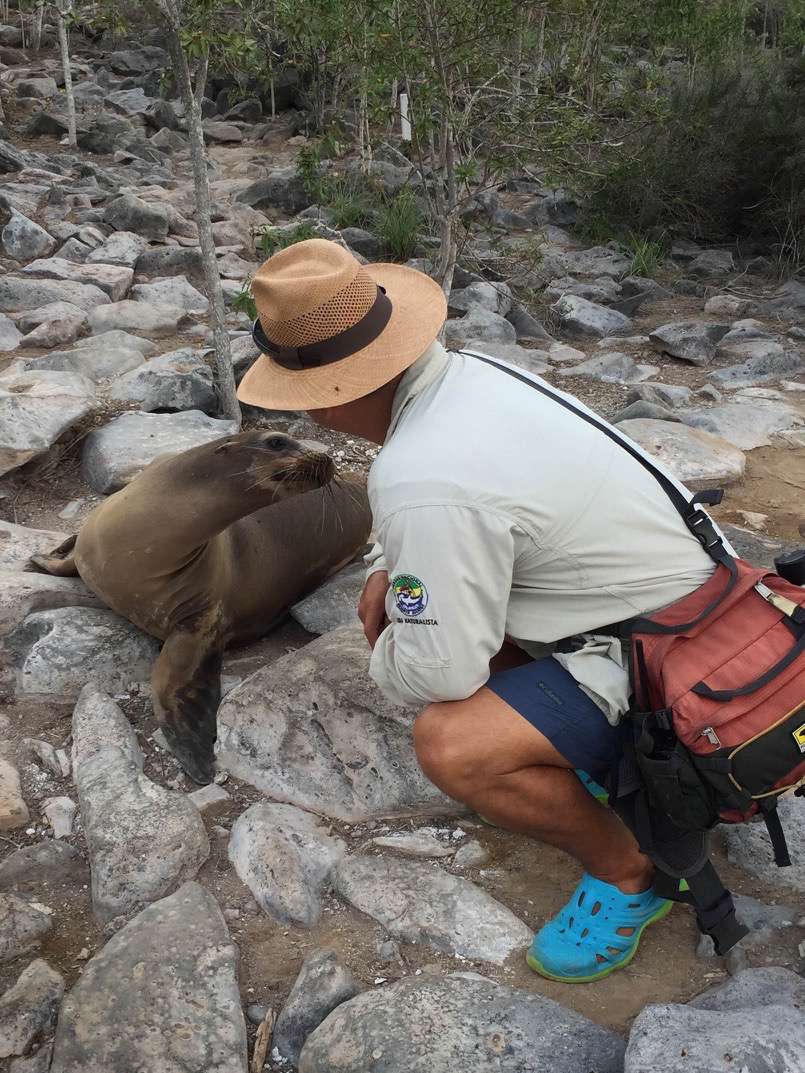
A blue-footed naturalist pauses to say hello to a friendly sea lion.

Puffer fish have the ability to ingest large amounts of water to increase their size quickly and discourage predators. Nearly every species also has a neurotoxin that makes them foul tasting, even lethal to other fish.

A certified naturalist accompanies each group of visitors and keeps a watchful eye over his charges.
The naturalist guides take their jobs seriously. They are extremely knowledgeable and are passionate about their work. They have coveted jobs and some of them have been working in that profession for decades. Groups rarely exceed more than a few dozen in size with humans often outnumbered by birds and animals. Of 20 islands, 15 have no human habitation, and there are only about 25,000 people living on the other five islands. But human population growth is a problem and has been increasing six to eight percent a year, in part because better paying jobs can be found on the Galapagos Islands, compared with the mainland of Ecuador. And what nature lover wouldn’t aspire to be a certified naturalist on the Galapagos Islands?

The sun slips behind this crag, part of the Galapagos Islands archipelago.

Nature finds a way, and here a small trail of grass has begun to push its roots into the barren rock.

The dynamics of volcanism can be seen at this island where once-liquid lava spilled down like cake batter falling into a pan.

The harsh inferno of lava flows results in beautiful patterns that in thousands of years will be covered with grasses and other plants.

This bit of lava may have held gasses that caused it to puff up as it spewed from the earth.

A barren landscape nearly devoid of life but Mother Nature is creating a home for plants, animals, birds and other wildlife.

A blade of grass can easily be trampled underfoot, but it also has the power to force its roots into rock and take hold.

This lava tube provides a cool respite from the heat and sun of the Galapagos Islands and leaves evidence of where lava once flowed.
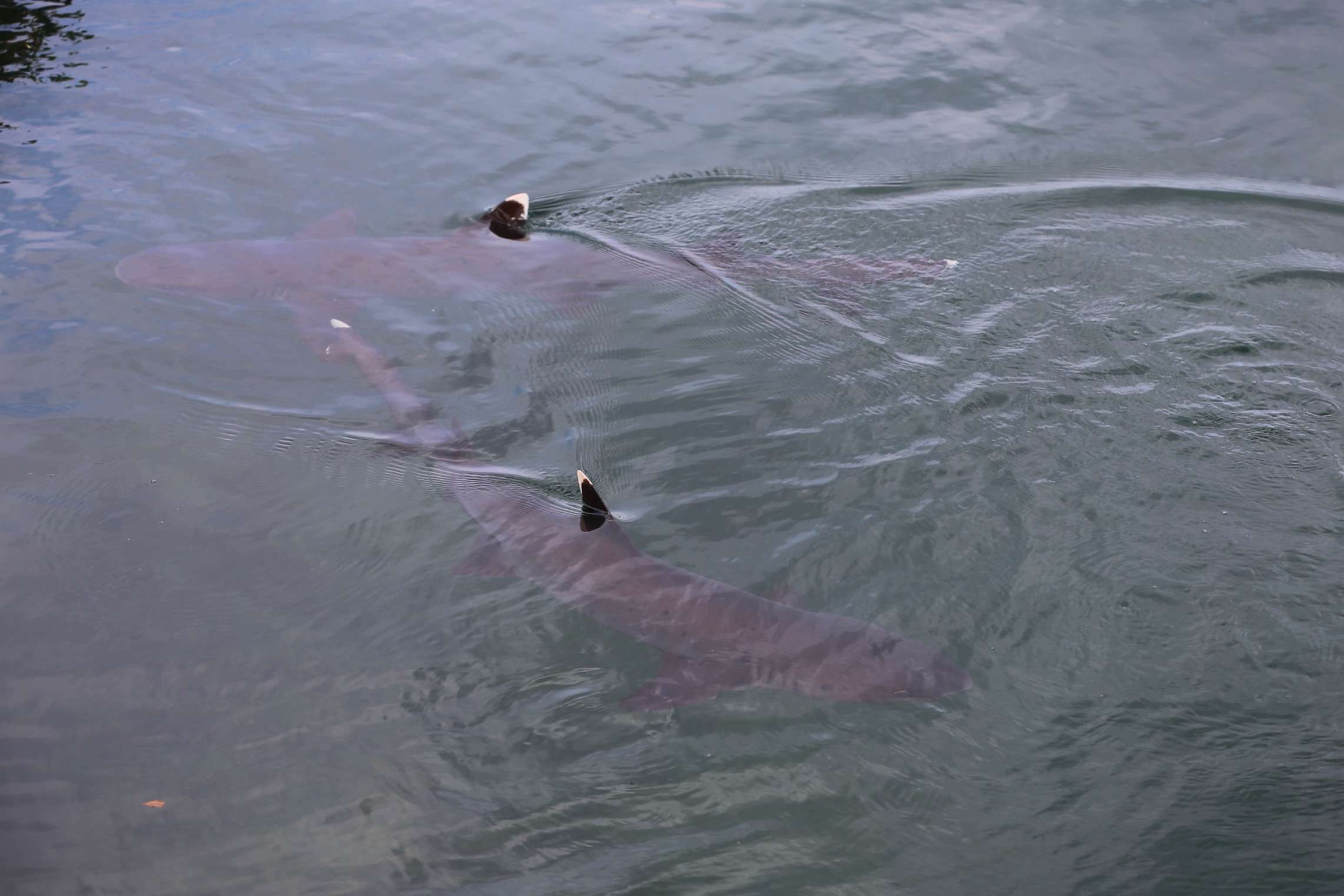
This pair of white tip sharks circle each other in a lagoon. Jacques Cousteau described them as one of the most aggressive species of shark.
One of the reasons Charles Darwin and current-day visitors are struck by the Galapagos Islands is the diversity. The volcanic activity results in islands with differing mineral compositions – some islands have more iron, so the rocks and soil are redder, for example. Some islands are better habitat for birds, and some are better for giant tortoises, sea lions, and various types of iguanas. Flora and fauna on older islands are usually more abundant and newer islands can be a rugged moonscape of jagged-edged lava that has barely any life on it.
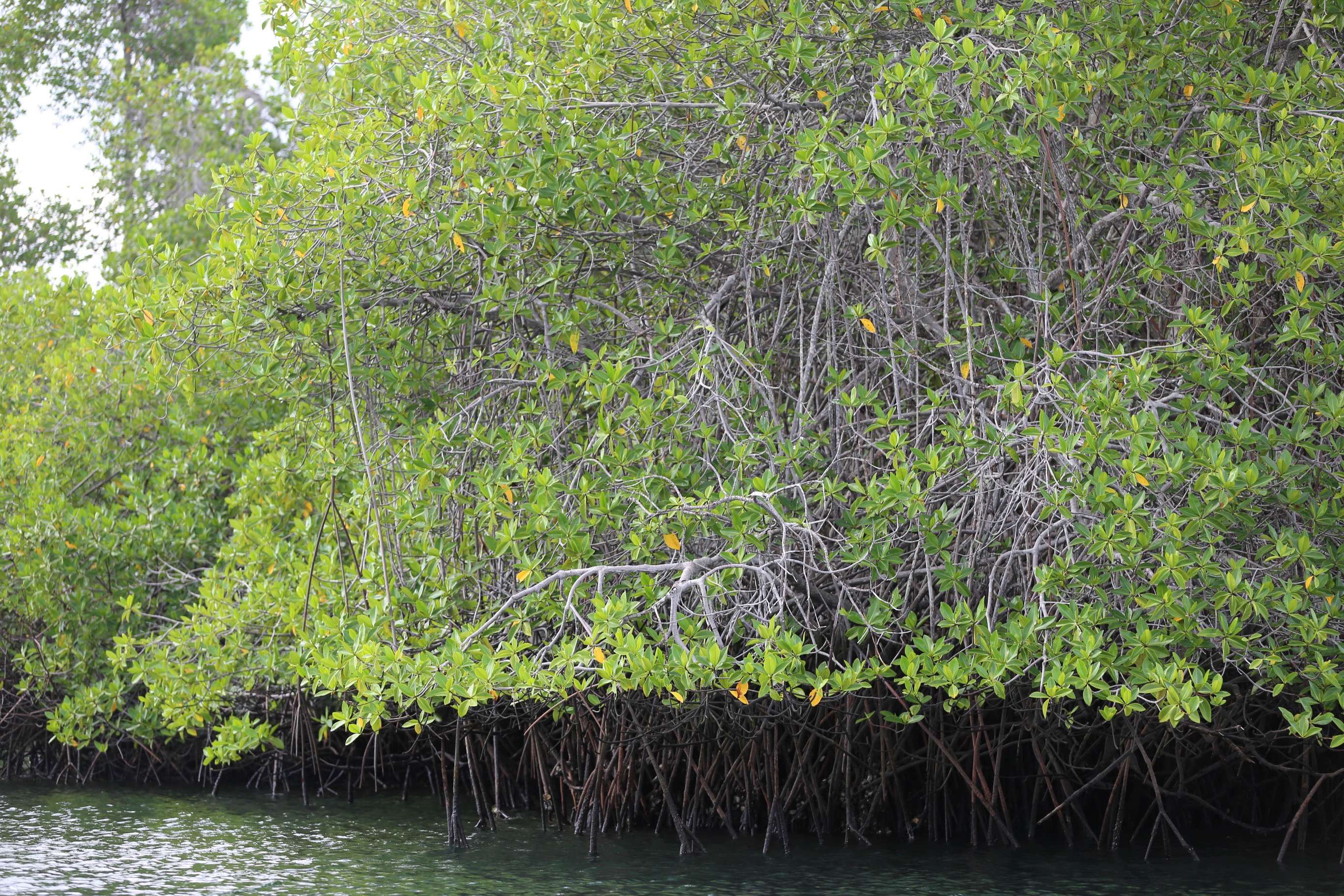
Mangrove trees have taken root on this islet and provide cover and shelter for birds and other wildlife.

As a mangrove seed matures, it will fall into the water where it will take hold and before long, a grove will establish.
The islands have their own microclimates, based on size, elevation and position. Some islands get more rain than other islands and this affects the abundance and types of plants, grasses and cacti that grow on them.

Each of the islands in the Galapagos chain is different, based on age, mineral composition and average rainfall.

The soils on some islands are more hospitable to plants and succulents.

Other islands are either newer, or plants have a tougher time getting established.

Regardless of their age or general composition, all the islands of the Galapagos are geologic wonders.

Beautiful to the eye, but inches below the water, the reefs are jagged and can be dangerous.

Deep in the crater of this caldera a small pool of water accumulates, nourishing the grasses and trees that grow up its sides.

The crew drops the anchor after the ship has moved to a different island for a new adventure the next day.

The captain, left, carefully monitors his crew and ship as it is positioned to anchor at the next island.

Charts and log entries track the comings and goings of ships.

While passengers spend the day exploring an island, the ship patiently awaits their return.
The two main ways to visit the islands is to stay at one of the hotels, or book passage on the tour ships that are specially designed to accommodate passengers. Some hotels are high end and offer excursions to various islands. (Apartments, homes and rooms can also be found through websites geared toward the sharing economy.) The advantage to staying aboard a passenger ship is it moves to a new island each night giving visitors more time to see the sights and more islands to enjoy altogether. Individual ship owners can sail to the islands. But they are limited in their length of stay and are accompanied by certified naturalists when making excursions to protected islands.

The Galapagos tortoises are one of the islands most well known creatures. They can be found on seven of the islands.

These giants can live to be 100 years old.

Daytime temperatures in the Galapagos Islands can be quite warm, so a pond is a great place for a giant tortoise to cool off between snacks.

When sailors were visiting the Galapagos Islands, they often captured giant tortoises for food, keeping them alive aboard ships up to months at a time.
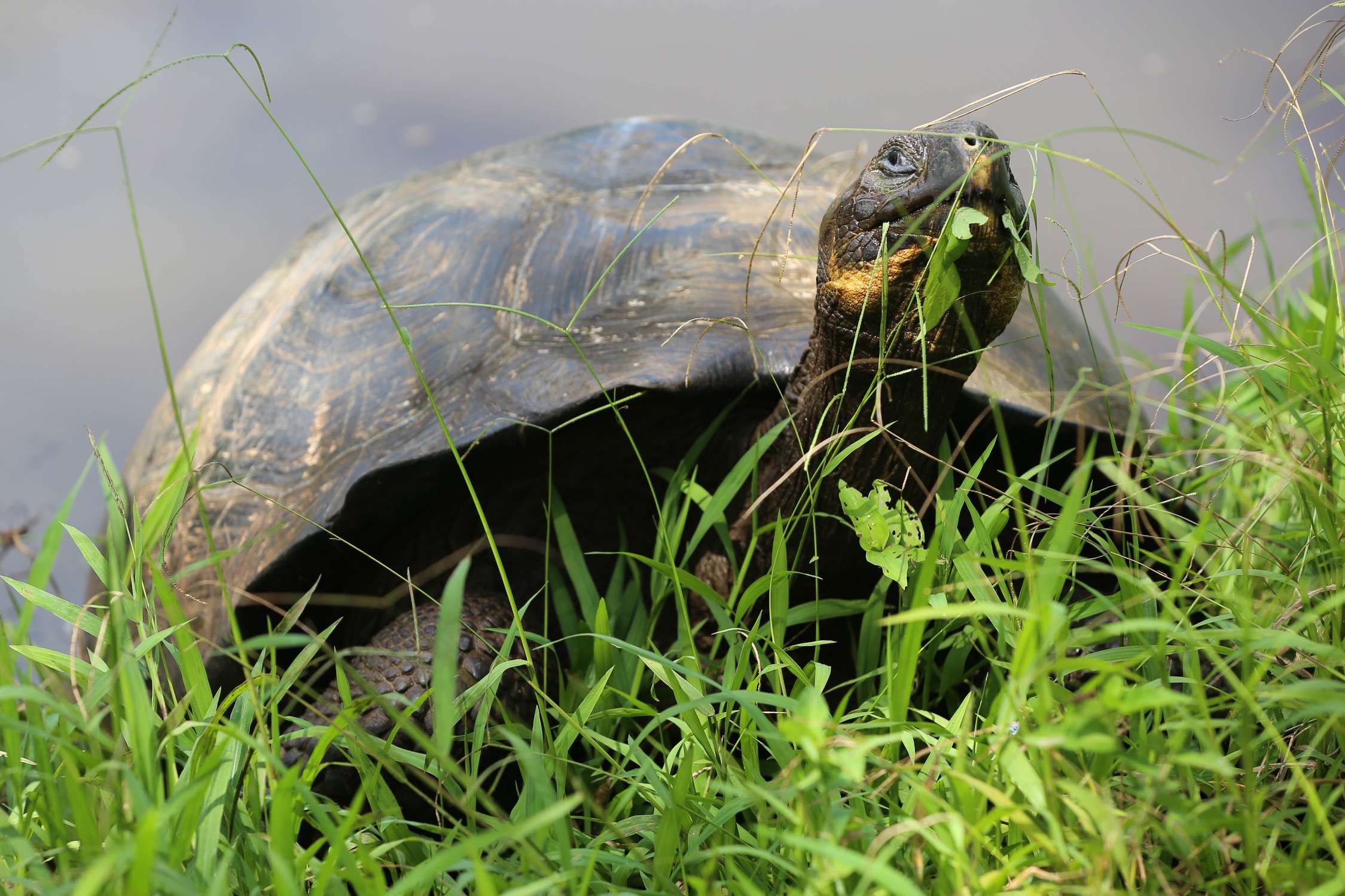
A bit of grass, some leaves, a place to cool off and some room to roam is about all the giant tortoise needs.
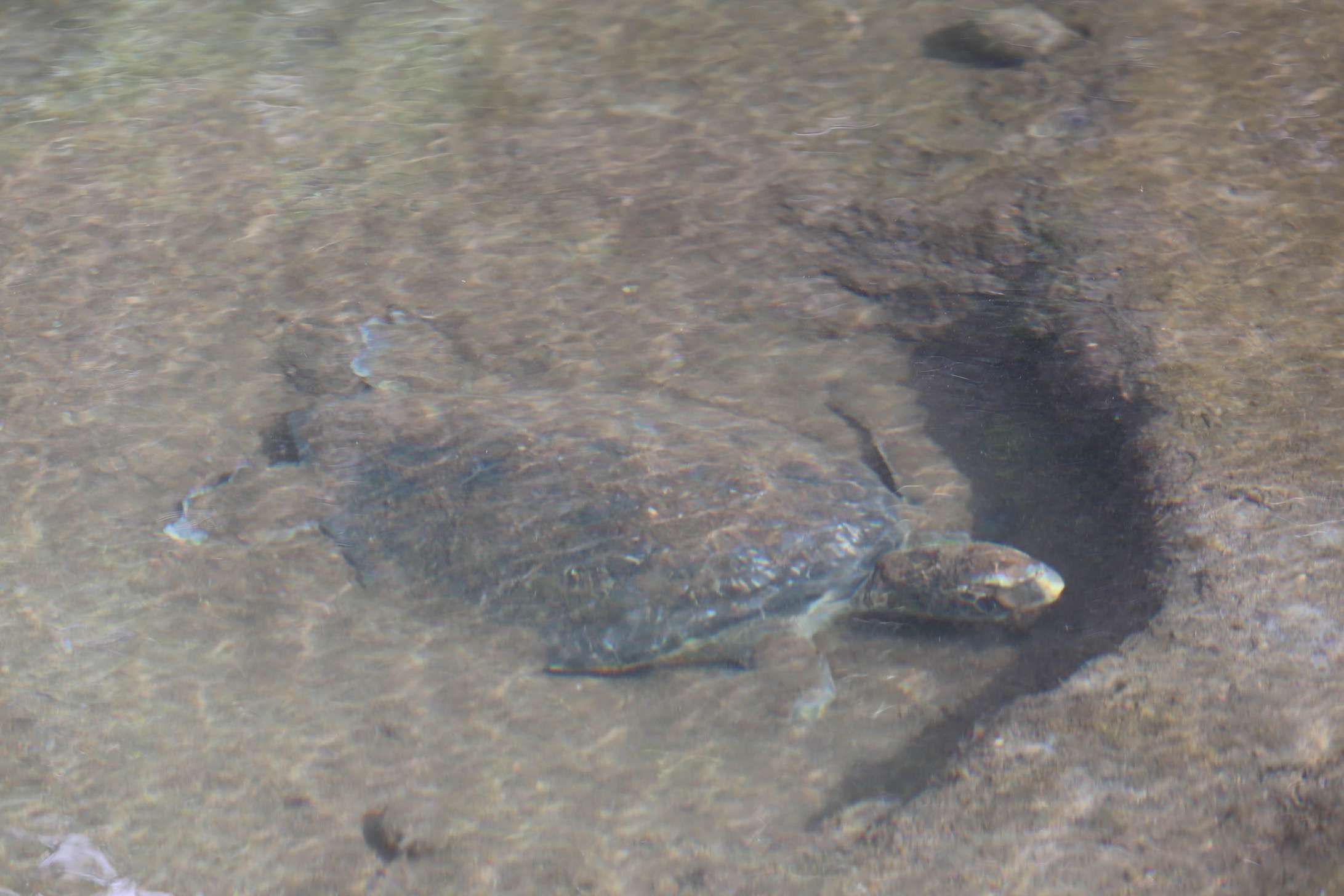
A green sea turtle waits on the bottom of a lagoon on one of the islets.

Walking on land is an arduous task for green sea turtles, but in the water they seem to fly with an elegant grace.
In 2014, just over 215,000 people visited the Galapagos Islands, with 65 percent of visitors staying at hotels or rentals on islands and 35 percent staying aboard specialty cruise ships. Virtually all visitors arrived at one of the two airports on the islands. Slightly fewer than one-third of the visitors that year are Ecuadorians and the remainder were international visitors, with about 25 percent of the total visitors from the United States.

This spot has been in use for many, many years as a post office, where sailors would leave mail to be sent home to family and friends. Now tourists are encouraged to leave a postcard that will sooner — or later — be taken by another visitor to be dropped off to the recipient in person.

Both are friendly fellows, but the bird lives at the post office and is quite happy to flit about and land on hat brims…

…or on an outstretched arm, even cameras.

But the bird only stays in one spot for just a bit, and then it’s on to the next hat!
No matter who you are, where you come from, how you get there, where, or how long you stay, or even how many islands you visit, you will forever remember the Galapagos Islands as one of the truly magnificent places on the planet where the wild creatures rule and humans are grateful for a chance to visit.
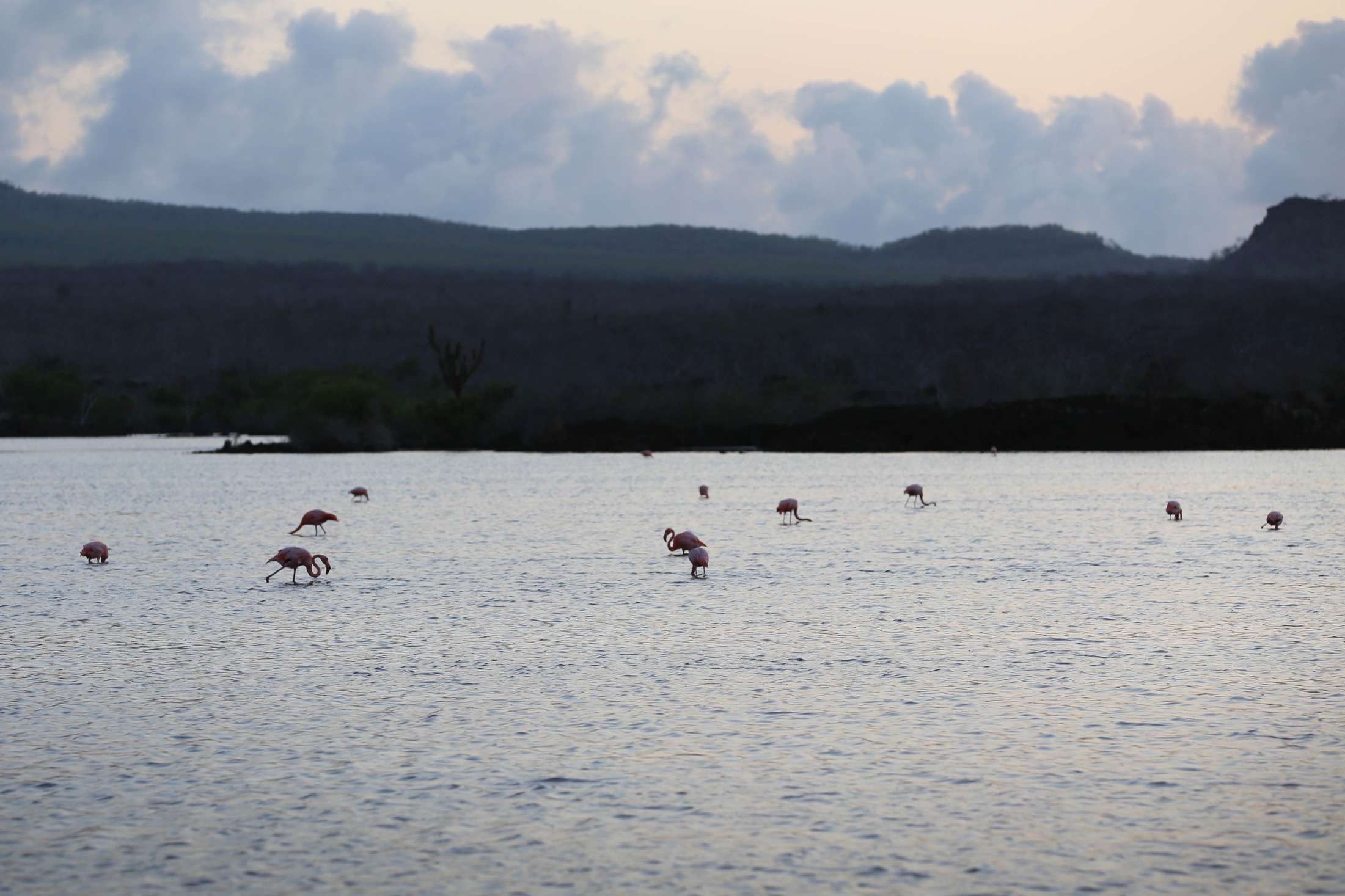
A flamboyance of flamingos searches for food on a warm afternoon.

A pair of flamingos relax in a still pond.

With long graceful necks and stilt-like legs, flamingos get their color from nutrients in the foods they eat.
For more information about the Galapagos Islands, click over to these websites:
wikipedia.org/Galapagos_Islands
nationalgeographic.com/world-heritage/galapagos-islands
